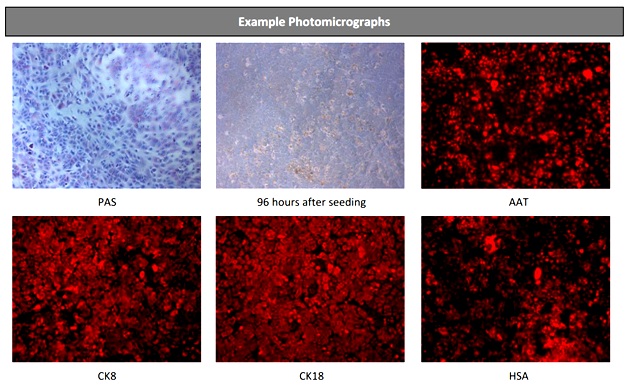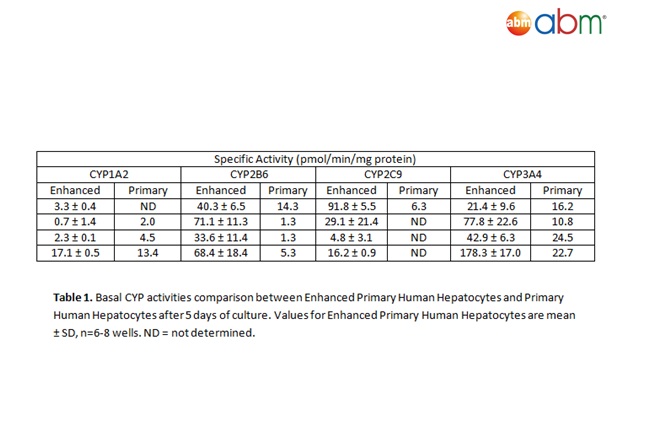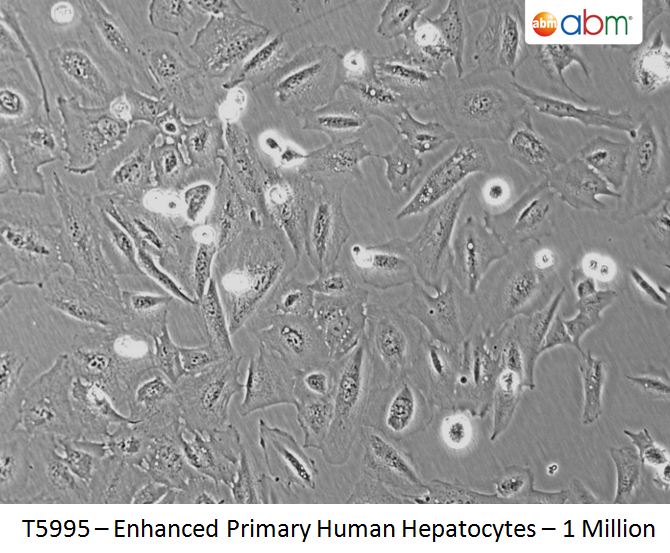Enhanced Primary Human Hepatocytes – 1 Million
Specifications
| Description |
Enhanced Primary Human Hepatocytes are expanded primary cells which retains the physiologically relevant profile and phenotype of primary hepatocytes. These cells are ready-to-use for applications in research and development, such as viral infections, screening, co-cultures, transient transfection, and for metabolism studies. The late expansion cells are tested for CYP induction and inhibition. It is not recommended for further extensive passaging after thawing but can be used for long term culture which is necessary for cell-based assays.
|
||||||
| Cat. No. | T5995 | ||||||
| Name | Enhanced Primary Human Hepatocytes – 1 Million | ||||||
| Unit | 1x10⁶ cells / 1.0 ml | ||||||
| Price | Inquiry | ||||||
| Category | Primary Cells | ||||||
| Cell Type | Primary Cells | ||||||
| Organism | Human (H. sapiens) | ||||||
| Tissue | Liver | ||||||
| Cell Morphology | Polygonal | ||||||
| Growth Properties | Adherent, polygonal | ||||||
| Seeding Density (cells/cm2) | 10,000 | ||||||
| Propagation Method |
Use of Applied Cell Extracellular Matrix (G422) is required for cell adhesion to the culture vessels. Grow cells in ECM-coated culture vessels with the following conditions. We strongly recommend end users to purchase the Applied Cell Extracellular Matrix (G422) to coat your cell culture vessels. Use the ready-to-use Hepatocyte Thawing Medium (TM102) and the Enhanced Primary Human Hepatocytes Media Kit (TM103) which comes with the Hepatocyte Growth Basal Medium, and Hepatocyte Growth Supplement Mix available from abm . Atmosphere: air: 95%, CO?: 5%; Temperature: 37.0°C. To make complete Hepatocyte Growth Basal Medium add the entire content of Hepatocyte Growth Supplement Mix into Hepatocyte Growth Basal Medium and mix properly in BioSafety Cabinet. Addition of the Hepatocyte Growth Supplement Mix may change medium appearance more opaque. To thaw: 1. Pre-warm Hepatocyte Thawing Medium and fully supplemented Hepatocyte Growth Medium to room temperature. 2. Carefully remove cryovial from storage tank. 3. Thaw cells in 37°C water bath until only a small chunk of ice is left. Do not shake the vial, or take it out of the water during thawing, as this will damage the cells. 4. Spray the vial and the tube containing 50 ml of thawing medium with 70% ethanol and transfer to a Biosafety cabinet. 5. Transfer the now completely thawed cell suspension from the cryovial into 50 ml Hepatocyte Thawing Medium by gently pouring the cells into the medium. 6. Use a 1 ml pipette to transfer 1 ml of the thawing medium back to the cryovial and pour the contents back into the 50 ml tube. Repeat this process twice to completely remove the cells from the cryovial. 7. Pellet the cells by centrifuging at 90×g for 5 min at RT. Important note: Higher g-forces will significantly reduce cell recovery. 8. Aspirate the supernatant without disturbing the pellet. Leave approximately 200-400 ?l medium on top of the cells. 9. Gently loosen and re-suspend the cells without adding any extra medium by agitating and rotating the tube. Do not vortex or shake the cells as this will compromise cell survival. 10. Add an appropriate volume of pre-warmed supplemented Hepatocyte Growth Medium to the pellet (~1ml per million cells thawed) and re-suspend the cells. Avoid pipetting the cells up and down. 11. Determine viable cell number by cell count. 12. Dilute hepatocytes in pre-warmed, fully supplemented Hepatocyte Growth Medium and seed at ~10,000 cells/cm2 in collagen coated cell culture flasks (e.g. T175) or appropriate cell culture dishes. 13. Incubate the cells at 95% humidity, 37°C and 5% CO2. |
||||||
| Growth Conditions | Use of PriCoat™ T25 Flasks (G299) or Applied Cell Extracellular Matrix (G422) is required for cell adhesion to the culture vessels. Ready-to-use Hepatocyte Thawing Medium (TM102) and the Enhanced Primary Human Hepatocytes Media Kit (TM103) which comes with the Hepatocyte Growth Basal Medium, and Hepatocyte Growth Supplement Mix are required to grow the cells, 37.0°C, 5% CO₂. | ||||||
| Subculture Protocol |
Volumes given below are for a T75 flask; proportionally increase or decrease the volume as required per culture vessel size. Subculture cells once the culture vessel is 80% confluent. 1. Aspirate the culture media, and add 2-3ml of pre-warmed 0.25% Trypsin-EDTA to the culture vessel. 2. Observe the cells under a microscope to confirm detachment (typically within 2-10 minutes). Cells that are difficult to detach can be put in 37°C, for several minutes to facilitate detachment. 3. Neutralize Trypsin-EDTA by adding an equal volume of the complete growth media into the culture vessel. 4. Transfer the culture suspension into a sterile centrifuge tube, and centrifuge at 125xg for 5 minutes. The actual centrifuge duration and speed may vary depending on the cell type. 5. Aspirate the supernatant, and re-suspend the pellet with pre-warmed fresh complete growth media. Add appropriate aliquots of the cell suspension to new culture vessels, as desired. 6. Incubate the cells at the recommended conditions. |
||||||
| QC |
Each lot has been tested for:
|
||||||
| Application | Research Use Only. | ||||||
| Storage Condition | Vapor phase of liquid nitrogen, or below -130°C. | ||||||
| BioSafety | II | ||||||
| Disclaimer |
1. All of abm's cell biology products are for research use ONLY and NOT for therapeutic/diagnostic applications. abm is not liable for any repercussions arising from the use of its cell biology product(s) in therapeutic/diagnostic or any other non-RUO application(s). 2. abm makes no warranties or representations as to the accuracy of the information on this site. Citations from literature are provided for informational purposes only. abm does not warrant that such information has been shown to be accurate. 3. abm warrants that cells shall be viable upon initiation of culture for a period of thirty (30) days after shipment and that they shall meet the specifications on the applicable abm Material Product Information sheet, certificate of analysis, and/or catalog description. Such thirty (30) day period is referred to herein as the "Warranty Period". |
STR
There are no STR for this product yet!
FAQs
| I want to make sure these cells express my gene of interest before I decide to buy the cell line. Can you provide a sample so this can be tested? | |
|
We do not perform extensive downstream characterization, or gene expression profiling of our cell lines. However, you can check the ‘References’ tab to see if a publication is available, or you can contact us to see if RNA or cell lysates are available for your cell line of interest. Please directly contact us for further information at quotes@abmgood.com.
|
| Does abm's PriGrow series medium contain antibiotics? | |
|
No, the medium does not contain antibiotics and needs to be supplemented by the end-user as desired.
|
| Do I need to use abm's media and Applied Cell Extracellular Matrix (G422) to culture my cells? | |
|
We strongly encourage using the recommended media and culture conditions described in the "Growth Conditions" section as they have been optimized for cell growth. Other supplier's media and coating conditions have not been tested.
|
| What is the difference between Applied Cell Extracellular Matrix (G422) and Collagen Coating? | |
|
The main component of our Applied Cell Extracellular Matrix (G422) is type I collagen specifically. For more information on abm's Applied Cell Extracellular Matrix please visit: http://www.abmgood.com/Applied-Cell-Extracellular-Matrix-G422.html.
|
| Do I have to use T25 ECM-coated flasks for growing the cells? | |
|
We strongly recommend thawing cells in the T25 flasks specified on the cell-specific product page to ensure optimal post-thaw recovery of the frozen cells before testing other culture vessels.
|
| If I want to plate these cells to multi-well plates (e.g. 96 well plates) or dishes, how should I prepare the plates? | |
| What percentage of Trypsin-EDTA should be used to subculture cells? Can I use Trypsin-EDTA containing phenol red? | |
|
The standard concentration used for subculturing is 0.25% Trypsin-EDTA, available at abm (Cat. No. TM050). Yes, Trypsin-EDTA containing phenol red can be used as it does not interfere with trypsinization.
|
| How often do I need to change the media? | |
|
Media should be changed every 2-3 days or as specified within the recommended growth conditions.
|
| Why are these cells classified as biosafety level II? | |
|
We follow the CDC-NIH recommendations that all mammalian sourced products should be handled at the Biological Safety Level 2 to minimize exposure of potentially infectious products. This information can be found in 'Biosafety in Microbiological and Biomedical Laboratories' (1999). Your institution's Safety Officer or Technical Services will be able to make the call as to whether BioSafety Level I is possible with these cells at your site, if desired.
|
| How long can I store frozen vials? | |
|
Cells that are properly frozen using an effective cryoprotective agent can be stored in liquid nitrogen vapor phase (or below -130°C) indefinitely without affecting viability.
|
| What is the recommended storage temperature for cells? | |
|
In general, if you received:
|
| Can I substitute heat-inactivated FBS with FBS or vice versa? | |
|
FBS and heat-inactivated FBS are different in their composition; they cannot be substituted for one another.
|
| My cells are not detaching, what method do you recommend to trypsinize the cells? | |
|
| How are live cells shipped? | |
|
Live cells are shipped as a live culture in a T12.5 flask. Cells are seeded at an optimal confluency to avoid metabolic waste build up during transport. In addition, we thoroughly test our cell lines for functional freeze-thaw recovery. For more information on how to handle live cells, please view our detailed instructions here (https://www.abmgood.com/uploads/document/Cell_Handling_Instructions_Upon_Arrival_150623.pdf).
|
| Why are cells not attaching and forming clumps after subculturing with trypsin? | |
|
Cells form clumps and display attachment issues when the trypsinization agent is not effectively neutralized. To completely neutralize the trypsin agent, add an equal amount of complete growth media prior to centrifugation. Subtle changes in culture conditions, particularly in pH and the quality of serum used in the growth medium, may also affect the amount of clumping exhibited by the cells.
|
| Why are my cells forming clumps after plating? | |
|
It is important to ensure cell clumps are broken up through gentle re-suspension by pipetting up and down several times after pelleting cells by centrifugation. This will ensure a homogenous single cell suspension for even plating.
|
| Do I need to add the selection drug to the complete growth medium? | |
|
We recommend maintaining selection pressure using the drug concentration specified in the Growth Conditions section.
|
| Where can I find the CoA for my product? | |
|
Certificates of analysis can be found here (https://www.abmgood.com/CoA-Library.html).
|
References
- Zhang, Y. (2023). Elucidating the functional role of CCCTC-binding factor (CTCF) in hepatocellular carcinoma.
Controls and Related Product:
Other Cell Lines
Select Species:
African Green Monkey (C. aethiops)
(0)
Bat
(0)
Bat (Chiroptera)
(0)
Bee
(0)
Bottlenose Dolphin (Tursiops)
(0)
Cabbage Looper (T. ni)
(0)
Cat (Feline)
(0)
Cattle
(0)
Chicken (Galline)
(0)
Chinese Hamster (C. griseus)
(0)
Cow (Bovine)
(0)
Deer (Cervidae)
(0)
Dog (Canine)
(0)
Duck (Anas)
(0)
Duck (Anatidae)
(0)
E. coli
(0)
European Sea Bass
(0)
European Sea Bass (D. labrax)
(0)
Fall Armyworm (S. frugiperda)
(0)
Fish
(0)
Fly (D. melanogaster)
(0)
Frog (Xenopus)
(0)
Fruit Fly (D. melanogaster)
(0)
Gilthead Sea Bream (S. aurata)
(0)
Goat (Capra)
(0)
Golden Hamster (M. auratus)
(0)
Goose (Anatidae)
(0)
Green Monkey (C. aethiops)
(0)
Green Monkey (C. sabaeus)
(0)
Hamster (M. auratus)
(0)
Horse (Equine)
(0)
Human
(0)
Human (H. sapiens)
(0)
Insect
(0)
Insect (Insecta)
(0)
Killifish (F. heteroclitus)
(0)
Luciola italica
(0)
Marmoset (Primate)
(0)
Mink
(0)
Mink (N. vison)
(0)
Monkey (Primate)
(0)
Moth (S. frugiperda)
(0)
Mouse
(0)
Mouse (M. musculus)
(0)
N/A
(0)
Other
(0)
Photinus pyralis
(0)
Pig (Porcine)
(0)
Quail (Coturnix)
(0)
Rabbit (Leporidae)
(0)
Rabbit (Leporine)
(0)
Rainbow Trout (O. mykiss)
(0)
Rat (R. norvegicus)
(0)
Rat (Rattus)
(0)
Renilla reniformis
(0)
Roundworm (C. elegans)
(0)
Rous Sarcoma Virus (RSV)
(0)
SARS-CoV-2
(0)
Sheep (Ovine)
(0)
Sheep (Ovis)
(0)
Turtle
(0)
Turtle (Testudines)
(0)
Universal
(0)
Zebrafish (D. rerio)
(0)
Select Tissue:
0
(0)
Achilles Tendon
(0)
Adipose
(0)
Adrenal Gland
(0)
Adrenal Glands
(0)
Airway
(0)
Airway/Lung
(0)
Amniotic Sac
(0)
Antimesometrial Decidua
(0)
Antler
(0)
Ascites
(0)
Auditory
(0)
Bee Cell
(0)
Bile Duct
(0)
Bladder
(0)
Blood
(0)
Blood (Immune)
(0)
Blood Vessel
(0)
Bone
(0)
Bone Marrow
(0)
Brain
(0)
Breast
(0)
CAF, Tumor
(0)
Caput Epididymis
(0)
Cartilage
(0)
Cerebrospinal Fluid
(0)
Cervix
(0)
Colon
(0)
Connective Tissue
(0)
Cord Blood
(0)
Digestive
(0)
Digestive System
(0)
Ear
(0)
Embryo
(0)
embryonic
(0)
Endometria
(0)
Endometrium
(0)
Esophagus
(0)
Eye
(0)
Fallopian Tube
(0)
Fibroblast
(0)
Gingiva
(0)
Hair
(0)
Hair Follicle
(0)
Head/Neck
(0)
Heart
(0)
HeLa
(0)
Hepatocellular Carcinoma
(0)
Hippocampus
(0)
Intestinal
(0)
Intestine
(0)
Kidney
(0)
Kidney, Cortex/Proximal tubule
(0)
Labial Salivary Gland
(0)
Larynx
(0)
Liver
(0)
Lung
(0)
Lung Carcinoma
(0)
Lung, bronchus
(0)
Lymph
(0)
Lymph node
(0)
Lymphatic System
(0)
lymphoblast
(0)
Malignant melanoma
(0)
Mammary
(0)
Mesencephalic Tissue
(0)
Mesentery
(0)
Microglia
(0)
Mouth/Oral
(0)
Muscle
(0)
Myoblast
(0)
Nasal Mucosa
(0)
Nerve
(0)
Nervous System
(0)
Oesophageal
(0)
Oesophagus
(0)
Oral
(0)
Organ of Corti
(0)
Other
(0)
Ovary
(0)
Pancreas
(0)
Pancreatic
(0)
Parathyroid
(0)
Penile
(0)
Peripheral Blood
(0)
Peripheral Blood Mononuclear Cells
(0)
Peritoneal
(0)
Peritoneum
(0)
Pharynx
(0)
Pituitary
(0)
Pituitary Gland
(0)
Pituitary Tumor
(0)
Placenta
(0)
promyelocytic leukemia
(0)
Prostate
(0)
Prostate carcinoma
(0)
Renal
(0)
Reproductive
(0)
Reproductive System
(0)
Retina
(0)
Salivary Gland
(0)
Sciatic Nerve
(0)
Sertoli
(0)
Skeletal
(0)
Skeletal Muscle
(0)
Skin
(0)
Skin ; Keratinocytes
(0)
Small intestine
(0)
Smooth Muscle
(0)
Soft Tissue
(0)
Spinal
(0)
Spleen
(0)
Stem Cell
(0)
Stomach
(0)
Straitum
(0)
Sweat Gland
(0)
Tendon
(0)
Testes
(0)
Testis
(0)
Thymic
(0)
Thymus
(0)
Thyroid
(0)
Tongue
(0)
Tonsil
(0)
Trachea
(0)
Tumor
(0)
Umbilical Cord
(0)
Unknown
(0)
Urethra
(0)
Urinary Tract
(0)
Uterus
(0)
Uterus; endometrium
(0)
Vascular Endothelium
(0)
Ventral Mesencephalon
(0)
Vertebral Disc
(0)





